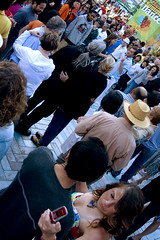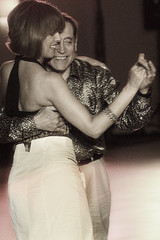« July 2008 | Main | September 2008 »
August 30, 2008
What Tango Music Should I Buy?
A tango beginner asked me to recommend about five CDs of traditional tango music that he can listen to and practice.
Listening to the music is such a critical part of becoming a good dancer.
It's difficult to precisely name CDs, because there is much to choose from. It would be easier just to name orchestras. But here are my picks, which would give anyone a good starter set of commercially released CDs.
1. RCA Victor 100 Años, by Carlos Di Sarli
2. Poema, by Francisco Canaro
3. Yo Soy de Parque Patricios, by Angel D'Agostino & Angel Vargas
4. Solo Tango: Instrumental Vol.1, by Juan D'Arienzo
5. Al Compas Del Corazon, by Miguel Calo
6. Ausencia, by Osvaldo Pugliese
I like to buy from tangostore.com. They are in Bs As, where the exchange rate is decent and the shipping is reasonably prompt. A buyer can check out their mp3 samples before hand. I think it's good to choose music that appeals to you.
Also, Planet Tango sells their own DJ-selected compilations of CDs. The Planet Tango "Tandas" CDs have tangos, milongas and valses arranged in sets by various orchestras, and they are all selected explicitly for dancing (as opposed to just listening). It is a good way to become familiar with the most important dance orchestras.
Keith Elshaw has spent the last several years digitally remastering tango tracks and also sells his compilations on CD, or by MP3 download.
All of these websites are great places to explore and learn about tango music.
Posted by joegrohens at 05:17 PM | Comments (0)
August 16, 2008
What do Mark Spitz and Mike Phelps have to do with tango?
the mystery, the magic, the wonder, the innocence of never having done it before, those are the seeds of creativity that came into my personal story.
Last night Bob Costas from NBC interviewed Mark Spitz and Mike Phelps together.
Mike Phelps has just tied Mark Spitz's record of winning seven gold medals in a single Olympics game. Of course both men are in the same event - swimming.
I was really impressed with Mark Spitz last night. In contrast to Mike Phelps's inarticulate responses Spitz had some powerful words about Mike Phelps, about the mindset of competition at that level, and about how great Phelps's achievement is.
He told Phelps that he would come to realize that his greatness would have a tremendous impact on younger athletes, and that he had a huge responsibility to those coming after him, in what he showed them about sportsmanship and behavior and how he handled his competitions. And he said that he knew that Phelps was equal to that responsibility.
The assurance that Mark Spitz displayed in talking the greatness of Mike Phelps revealed a lot about Spitz's own inner confidence. It came across as "no self doubt whatsoever."
But then Spitz said something really interesting. He said that what kept him motivated and successful in his youthful days of swimming competition, in which he dominated the sport and broke many records, was "the mystery, the magic, the wonder, the innocence of never having done it before, those are the seeds of creativity that came into my personal story."
Doing something that you have never done before can be very scary. Having the aplomb to go forward into the challenge of the new, the unknown, that is an important quality.
That is the quality one needs in tango. Because the best dances are always the ones where you feel like you are setting out into undiscovered territory. Even if you are doing steps you have done before. If it feels like you don't know what's going to happen next, and you aren't sure if it's going to work, but you stay calm and immerse yourself in the moment - that is where the most memorable dances come from.
Posted by joegrohens at 05:53 PM | Comments (0)
August 15, 2008
Gustavo Santolalla
Article on Gustavo Santaolalla in NYT today. Bajofondo Tango Club plays in Central Park tonight.
Gustavo Santaolalla’s Film Scores Are Minimalist and His Tango Is Newfangled - NYTimes.com
“We don’t consider what we are doing as tango,” he said. “We are doing contemporary music, music that expresses the urban landscapes of Buenos Aires and Montevideo. Obviously tango will be present there. But milonga, candonga, murga” — three other local rhythms — “and rock, hip-hop and electronica are also part of the genetic map of this place.”
Posted by joegrohens at 01:11 PM
August 07, 2008
Codes of the milonga
Advice.
Two excellent articles on milonga customs and strategies for success.
Saber Milonguear 1 The obvious codes of the milonga.
Saber Milonguear 2 The hidden codes of the milonga.
Posted by joegrohens at 02:26 PM
August 06, 2008
Can you see the difference?
Apparently times have changed in one of my most fondly remembered milongas: Porteño y Bailarin.
Some years ago, when we were there, the dance floor was filled with an intriguing mix of dancers. Professional dancers went there (e.g., Gavito, Flaco Dany, Pupy Castello, Pulpo, Javier and Geraldine). But also it seemed that a lot of "ordinary" dancers were there too. It was like the title said - porteños (natives) and bailarines (dancers).
I actually liked seeing that someone as bizarre and non-traditional as Pulpo & Luiza would be on the floor with normal dancers, and nobody seemed to mind. Nobody was bumped. Everyone co-existed in peace and harmony, and respect. That's how it seemed to me. And the energy had a very creative and electric charge.
This first video comes from around that time, 2004. I didn't take the video.
This is possibly my favorite tango video on youtube. I like the music, I like the captured moments and evolution of the tandas. I love the waiter - so on the ball. One guy serving the whole place.
YouTube - Porteño Y Bailarin milonga
Recently a new video from this milonga appeared on youtube. It looks like tourists have taken over the dance floor, and neither professionals nor natives want to set foot on it.
Now the only person on the floor that's worth watching is the waiter.
YouTube - 080227 Milonga Porteno y Bailarin - Buenos Aires
Posted by joegrohens at 11:12 AM
August 05, 2008
rhythm
A Portrait of the Artist as a Young Man :: Concordance
[7927]--Rhythm, said Stephen, is the first formal esthetic relation of part
[7928] to part in any esthetic whole or of an esthetic whole to its part or
[7929] parts or of any part to the esthetic whole of which it is a part.
[7930]
[7931]--If that is rhythm, said Lynch, let me hear what you call beauty;
[7932] and, please remember, though I did eat a cake of cowdung once, that I
[7933] admire only beauty.
Posted by joegrohens at 02:38 AM
August 02, 2008
Levels (again)
This festival in Stockholm has an interestingly thorough and verbose way to define dancers' level of dance competence. They hope that dancers will enroll in workshops that have an appropriate level of difficulty. But, looking at the teachers (e.g., Arce / Montes), I think a lot would depend on the teachers you have studied with, and the style of dancing you do. According to this standard, I doubt that there are very many tango dancers of level 5 in the U.S. Even many people who teach tango are not at this level. Tango 59° Stockholm City
Levels
We urge you to be sensible when assessing your own level. Please read the following very carefully.
The level suitable for most participants who honestly can say to themselves that they are good at tango is Level 3.
Please do not assume that having attended Advanced level classes with other arrangers means that you should automatically choose classes on Level 4 or even 5. Level 4 is already higher than Advanced with many other arrangers.
Given the precision of the descriptions below, we are confident that it will be easy to find your appropriate level. However, if your first day at Tango 59 Degrees reveals otherwise, we will be happy to assist you in finding another level which better corresponds to your standard of dancing.
Level 1
You have no prior experience of tango, or have perhaps attended a few introductions before practicas. Level 2
You have danced for at least six months to a year or more, 2-3 times a week. You are working on the fundamental techniques, and think you are getting quite good at them. Level 3
You are an experienced social dancer. You feel entirely comfortable with the basics and are working on intermediate tango elements and some more advanced stuff, in both open and close embrace. It is quite natural for you to adapt your style of dancing to different orchestras. You have been dancing tango regularly, by which we mean at least 2-3 times a week, for at least 2 to 3 years or longer. Level 4
You are a very experienced dancer who feels equally confident in tango, vals and milonga. You have excellent balance and technique and dance with equal comfort in both close and open position. You really enjoy dancing on very crowded floors and never collide with, unsettle or disturb other couples. You have visited several tango festivals outside your country of residence, and have been dancing tango regularly, at least 2-3 times a week, for 4-5 years or longer. For the few:
Level 5
You are very advanced, even when considered on an international level. You master all elements mentioned for Level 4 and have gone beyond them. You are able to analyse complicated movements and combinations of movements at a single glance. You have certainly been dancing tango frequently over a very long period of time.
Posted by joegrohens at 08:54 AM | Comments (0)
Grant Park
Chicago Grant Park, Saturday, July 19, 2008 - Orchestra Tipica Imperial free concert.
I love the woman checking her phone messages in the foreground.
Posted by joegrohens at 12:02 AM | Comments (0)
August 01, 2008
Carlota & Erwin
At the Chicago Tango Week (July 4, 2008) - Friday night milonga.
Posted by joegrohens at 11:56 PM | Comments (0)
tiger woods's golf swing
Slo-mo biometric analysis of Tiger's swing. I wish they had these kinds of things for tango walking.
Posted by joegrohens at 11:29 AM | Comments (0)

